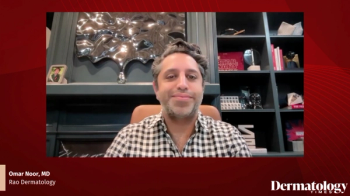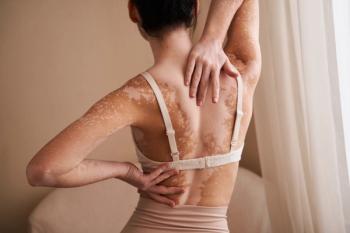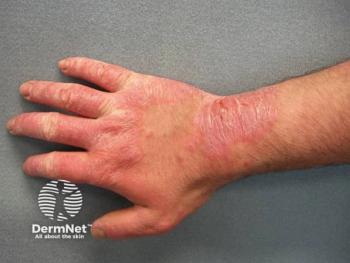
Study Reports Low Incidence of Injection Site Reactions in Nemolizumab-Treated Patients
Key Takeaways
- Nemolizumab treatment in atopic dermatitis and prurigo nodularis shows a low incidence of injection site reactions compared to placebo, with most reactions being mild.
- Phase 3 ARCADIA and OLYMPIA trials demonstrate nemolizumab's favorable safety profile, with fewer injection site reactions than placebo over 24 weeks.
Nearly all injection site reactions among patients in the ARCADIA 1/2 and OLYMPIA 1/2 clinical trials were mild and transient in nature.
A poster presented at the 2025 Society of Dermatology Physician Associates (SDPA) Annual Summer Dermatology Conference in Washington, DC, shared data revealing a low incident of injection site reactions observed among patients with atopic dermatitis (AD) and prurigo nodularis (PN) treated with nemolizumab (Nemluvio; Galderma).1
The poster analyzed recent study data evaluating the humanized monoclonal antibody targeting the IL-31 receptor alpha, including that of the phase 3 ARCADIA 1/2 studies for AD (NCT03985943; NCT03989349)2-3 and OLYMPIA 1/2 studies for PN (NCT04501666; NCT04501679),4-5 examining the safety profiles over a treatment period extending up to 24 weeks.
In the ARCADIA 1 trial, which involved patients with moderate to severe AD, the overall incidence of injection site reactions was modest. Specifically, during the first 16 weeks, only 1.1% (7 out of 616) of patients treated with 30 mg nemolizumab plus topical corticosteroids (TCs) or topical calcineurin inhibitors (TCIs) every 4 weeks experienced injection site reactions, compared to 0.3% (1 out of 321) in the placebo group.
The observed pattern was similar in the ARCADIA 2 trial, wherein during the first 16 weeks, 1.3% (7 out of 519) of patients on the same Q4W dosing regimen experienced injection site reactions, compared with 1.5% (4 out of 263) in the placebo group.
The most observed injection site reactions events included injection site pain, erythema, irritation, edema, and hematoma, with all reported injection site reactions being mild in nature. One case of severe injection site pain was documented, which was managed with non-steroidal anti-inflammatory drugs.
Similarly, in the OLYMPIA 1 trial involving patients with PN, the injection site reaction incidence was also low. Up to week 24, 1.6% (3 out of 187) of patients treated with 30 mg nemolizumab Q4W (plus TCs/TCIs) reported injection site reactions, versus 2.1% (2 out of 95) in the placebo group.
In OLYMPIA 2, reactions were observed in 0.5% (1 out of 183) of nemolizumab-treated patients versus 2.2% (2 out of 91) in the placebo group.
The most common specific reactions also included injection site pain, erythema, irritation, and bruising, with all reactions classified as mild and resolving spontaneously without treatment.
In total, 4 out of the 14 patients experiencing injection site reaction across all studies weighed ≥90 kg, indicating that higher body weight may influence injection site reaction occurrence, particularly in cases receiving the higher initial dose.
Across all trial phases, the data revealed that the occurrence of injection site reactions was consistently lower in the nemolizumab treatment arms than in the placebo groups. Overall, the phase 3 trial data suggest that nemolizumab administered intravenously every 4 weeks demonstrates a low incidence of mostly mild injection site reactions, with fewer events compared to placebo.
References
- Lio P, Kwatra SG, Silverberg JI, et al. Nemolizumab is associated with a low incidence of injection site reactions in the treatment of atopic dermatitis and prurigo nodularis. Poster presented at: Society of Dermatology Physician Associates (SDPA) 2025 Annual Summer Dermatology Conference; June 26-29, 2025; Washington, DC.
- Efficacy and safety of nemolizumab in subjects with moderate-to-severe atopic dermatitis. ClinicalTrials.gov. Updated August 14, 2024. Accessed June 28, 2025.
https://clinicaltrials.gov/study/NCT03985943 - Efficacy and safety of nemolizumab in subjects with moderate-to-severe atopic dermatitis. ClinicalTrials.gov. Updated August 14, 2024. Accessed June 28, 2025.
https://clinicaltrials.gov/study/NCT03989349 - Study to assess the efficacy and safety of nemolizumab (CD14152) in participants with prurigo nodularis (PN). ClinicalTrials.gov. Updated July 10, 2024. Accessed June 28, 2025.
https://clinicaltrials.gov/study/NCT04501666 - A study to assess the efficacy and safety of nemolizumab (CD14152) in participants with prurigo nodularis (PN). ClinicalTrials.gov. Updated July 10, 2024. Accessed June 28, 2025.
https://clinicaltrials.gov/study/NCT04501679
Make sure to keep up to date with the latest in coverage from the conference and subscribe to Dermatology Times to receive daily email updates .
Newsletter
Like what you’re reading? Subscribe to Dermatology Times for weekly updates on therapies, innovations, and real-world practice tips.



















